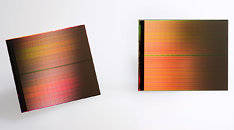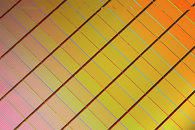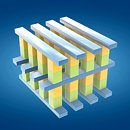Tuesday, July 28th 2015

Intel and Micron Produce Breakthrough Memory Technology
Intel Corporation and Micron Technology, Inc. today unveiled 3D XPoint technology, a non-volatile memory that has the potential to revolutionize any device, application or service that benefits from fast access to large sets of data. Now in production, 3D XPoint technology is a major breakthrough in memory process technology and the first new memory category since the introduction of NAND flash in 1989.
The explosion of connected devices and digital services is generating massive amounts of new data. To make this data useful, it must be stored and analyzed very quickly, creating challenges for service providers and system builders who must balance cost, power and performance trade-offs when they design memory and storage solutions. 3D XPoint technology combines the performance, density, power, non-volatility and cost advantages of all available memory technologies on the market today. The technology is up to 1,000 times faster and has up to 1,000 times greater endurance3 than NAND, and is 10 times denser than conventional memory."For decades, the industry has searched for ways to reduce the lag time between the processor and data to allow much faster analysis," said Rob Crooke, senior vice president and general manager of Intel's Non-Volatile Memory Solutions Group. "This new class of non-volatile memory achieves this goal and brings game-changing performance to memory and storage solutions."
"One of the most significant hurdles in modern computing is the time it takes the processor to reach data on long-term storage," said Mark Adams, president of Micron. "This new class of non-volatile memory is a revolutionary technology that allows for quick access to enormous data sets and enables entirely new applications."
As the digital world quickly grows - from 4.4 zettabytes of digital data created in 2013 to an expected 44 zettabytes by 2020 - 3D XPoint technology can turn this immense amount of data into valuable information in nanoseconds. For example, retailers may use 3D XPoint technology to more quickly identify fraud detection patterns in financial transactions; healthcare researchers could process and analyze larger data sets in real time, accelerating complex tasks such as genetic analysis and disease tracking.
The performance benefits of 3D XPoint technology could also enhance the PC experience, allowing consumers to enjoy faster interactive social media and collaboration as well as more immersive gaming experiences. The non-volatile nature of the technology also makes it a great choice for a variety of low-latency storage applications since data is not erased when the device is powered off.
New Recipe, Architecture for Breakthrough Memory Technology
Following more than a decade of research and development, 3D XPoint technology was built from the ground up to address the need for non-volatile, high-performance, high-endurance and high-capacity storage and memory at an affordable cost. It ushers in a new class of non-volatile memory that significantly reduces latencies, allowing much more data to be stored close to the processor and accessed at speeds previously impossible for non-volatile storage.
The innovative, transistor-less cross point architecture creates a three-dimensional checkerboard where memory cells sit at the intersection of word lines and bit lines, allowing the cells to be addressed individually. As a result, data can be written and read in small sizes, leading to faster and more efficient read/write processes.
3D XPoint technology will sample later this year with select customers, and Intel and Micron are developing individual products based on the technology.
The explosion of connected devices and digital services is generating massive amounts of new data. To make this data useful, it must be stored and analyzed very quickly, creating challenges for service providers and system builders who must balance cost, power and performance trade-offs when they design memory and storage solutions. 3D XPoint technology combines the performance, density, power, non-volatility and cost advantages of all available memory technologies on the market today. The technology is up to 1,000 times faster and has up to 1,000 times greater endurance3 than NAND, and is 10 times denser than conventional memory."For decades, the industry has searched for ways to reduce the lag time between the processor and data to allow much faster analysis," said Rob Crooke, senior vice president and general manager of Intel's Non-Volatile Memory Solutions Group. "This new class of non-volatile memory achieves this goal and brings game-changing performance to memory and storage solutions."
"One of the most significant hurdles in modern computing is the time it takes the processor to reach data on long-term storage," said Mark Adams, president of Micron. "This new class of non-volatile memory is a revolutionary technology that allows for quick access to enormous data sets and enables entirely new applications."
As the digital world quickly grows - from 4.4 zettabytes of digital data created in 2013 to an expected 44 zettabytes by 2020 - 3D XPoint technology can turn this immense amount of data into valuable information in nanoseconds. For example, retailers may use 3D XPoint technology to more quickly identify fraud detection patterns in financial transactions; healthcare researchers could process and analyze larger data sets in real time, accelerating complex tasks such as genetic analysis and disease tracking.
The performance benefits of 3D XPoint technology could also enhance the PC experience, allowing consumers to enjoy faster interactive social media and collaboration as well as more immersive gaming experiences. The non-volatile nature of the technology also makes it a great choice for a variety of low-latency storage applications since data is not erased when the device is powered off.
New Recipe, Architecture for Breakthrough Memory Technology
Following more than a decade of research and development, 3D XPoint technology was built from the ground up to address the need for non-volatile, high-performance, high-endurance and high-capacity storage and memory at an affordable cost. It ushers in a new class of non-volatile memory that significantly reduces latencies, allowing much more data to be stored close to the processor and accessed at speeds previously impossible for non-volatile storage.
The innovative, transistor-less cross point architecture creates a three-dimensional checkerboard where memory cells sit at the intersection of word lines and bit lines, allowing the cells to be addressed individually. As a result, data can be written and read in small sizes, leading to faster and more efficient read/write processes.
3D XPoint technology will sample later this year with select customers, and Intel and Micron are developing individual products based on the technology.



19 Comments on Intel and Micron Produce Breakthrough Memory Technology
There also is a 3 right after endurance, so maybe these are footnote-remains?
Well, damn! That is indeed a breakthrough.
A decade of research. I wonder what is just a gleam in the eye of some engineer/scientist right now that will pop up a decade from now after research that will be truly amazing.
edit: aw, emissary42 beat me to the joke
EDIT: wait... It's late I'm sorry. Nonvolatile means the opposite of that, lol...
It'll take a bit of effort to justify myself, but it seems like Intel has already done the work for me... Sigh...
www.bbc.com/news/technology-33675734
www.micron.com/about/innovations/3d-xpoint-technology
The highlights of the two articles (one from the BBC, the other from Micron) are as follows:
1) This won't be replacing NAND any time soon, primarily because of cost.
2) The chips they've got are faster than NAND, but slower than RAM.
3) The chips apparently cost less than the manufacture of RAM.
4) The primary current benefit to this technology is in sheer volumes. Think about a games server with no RAM, but two or three times the amount of this memory acting as a RAM substitute. Those 128 GB servers are now up to 256 GB or more memory, which amounts to more players, on way less servers, with lower power draws.
The 1000's of times is when the technology is significantly more matured, and not what we'd be seeing in the next few years. It's functionally extrapolating the future from potential mathematical models. In Intel's discussion with the BBC they're functionally suggesting it's to be used as a slower but bigger cache. Think about it like the hybrid SSD/HDD drives of the past. You're not as fast as the fastest stuff, but you get better bang for the monetary investment.
In short terms, it's a pair of perpendicularly arranged wire meshes, with a column between them. Each colum has a selector, and a storage segment. The storage segment is a memresistor. It's funny, but the BBC states exactly that while somehow forgetting such a thing was huge news only a couple of years ago. By passing through a given amount of power the storage segment varies in resistance, representing the 0 and 1. The intersection of each perpendicular wire only occurs once, so a single bit can be written at a time, and because the wires are perpendicular they can theoretically be stacked into a huge conglomeration (think something like the finfet transistors Intel previously introduced, only actually used in 3d).
Cheers.